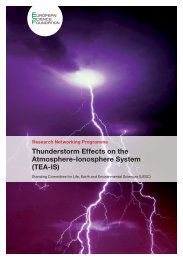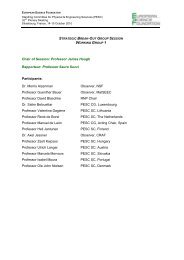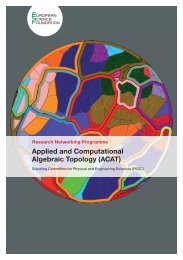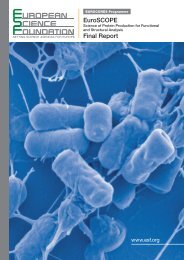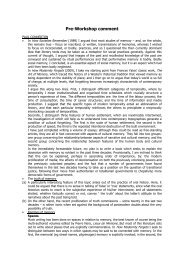Nanomedicine - European Science Foundation
Nanomedicine - European Science Foundation
Nanomedicine - European Science Foundation
Create successful ePaper yourself
Turn your PDF publications into a flip-book with our unique Google optimized e-Paper software.
18<br />
2. CURRENT STATUS OF NANOMEDICINE RESEARCH AND FORWARD LOOK<br />
background effects were seen as a particular challenge.<br />
Control and feedback technologies are<br />
needed to enable biomolecular recognition to be<br />
transferred into practical-to-use detector development.<br />
For analytical systems, increased sensitivity<br />
is needed, and analysis of functional systems.<br />
Development of new materials with complex<br />
functionality is already ongoing. This is particularly<br />
important in the context of tissue engineering scaffolds<br />
and arrays for detection. Spatial control of<br />
functionalisation is needed with ordered display of<br />
orthogonal functionality, and the ability to design<br />
into a system-triggered control of response; that is,<br />
new bioresponsive materials. Improved methods for<br />
surface functionalisation of colloids and surfaces are<br />
needed as well as new and validated analytical techniques<br />
to ensure safety and reproducibility. Integration<br />
of multiple-functionality (fluidics, with<br />
manipulation and detection) will enable translation<br />
to implantable configurations with telemetric detection<br />
and control.<br />
2.1.4. Workshop on Drug Delivery<br />
and Pharmaceutical Development<br />
Workshop participants:<br />
Dr María José Alonso, Prof. Ruth Duncan (chairs),<br />
Prof. Thomas Kissel (co-chair)<br />
Dr Oliver Bujok, Prof. Patrick Couvreur,<br />
Prof. Daan Crommelin, Dr Julie Deacon,<br />
Dr Luc Delattre, Prof. Mike Eaton,<br />
Prof. Claus-Michael Lehr, Dr Laurant Levy,<br />
Prof. Egbert Meijer, Dr Milada Sirova,<br />
Prof. Karel Ulbrich, Prof. Arto Urtti,<br />
Prof. Ernst Wagner, Dr Jaap Wilting<br />
Introduction<br />
Nanopharmaceuticals can be developed either as<br />
drug delivery systems or biologically active drug<br />
products. This sub-discipline was defined as the<br />
science and technology of nanometre size scale<br />
complex systems, consisting of at least two components,<br />
one of which is the active ingredient. In this<br />
field the concept of nanoscale was seen to range<br />
from 1 to 1 000 nm.<br />
Over the last three decades Europe has been at<br />
the forefront of the research and development of<br />
nanosized drug carriers including liposomes,<br />
nanoparticles, antibodies and their conjugates, polymers<br />
conjugates, molecular medicine (including<br />
proteins) and aspects of nanobiotechnology including<br />
tissue engineering and repair.<br />
There are a growing number of marketed nanosized<br />
drug delivery systems and imaging agents.<br />
Liposomes<br />
Nanoparticles<br />
Antibodies<br />
and their<br />
conjugates<br />
Nanopharmaceuticals<br />
Polymer-protein<br />
conjugates<br />
Viruses as<br />
viral vectors<br />
Polymer<br />
micelles<br />
Unimolecular polymer<br />
and dendrimer conjugates<br />
They include liposomal anticancer agents, antibodydrug<br />
conjugates, polymer-protein conjugates,<br />
nanoparticle-based imaging agents and an anticancer<br />
delivery system (see Appendix VI). There are<br />
also a large number of constructs (including the first<br />
polymer-based gene delivery system) in clinical<br />
development. These can be viewed as the firstgeneration<br />
<strong>Nanomedicine</strong>s and future developments<br />
will build on these successes.<br />
Scope of this discipline<br />
The nanosized drug delivery systems currently<br />
under development are either self-assembling, or<br />
involve covalent conjugation of multicomponent<br />
systems, e.g. drug, protein and polymer. The materials<br />
used to create such drug delivery systems typically<br />
include synthetic or semi-synthetic polymers,<br />
and/or natural materials such as lipids, polymers and<br />
proteins. If classified by function, many materials<br />
used for drug delivery are bioresponsive and/or<br />
biomimetic. An increasing number of nanosystems<br />
are being proposed as drug carriers. They include<br />
micelles, nanoemulsions, nanoparticles, nanocapsules,<br />
nanogels, liposomes, nanotubes, nanofibres,<br />
polymer therapeutics and nanodevices. Magnetic<br />
nanoparticles are being developed for diagnostic<br />
imaging and disease targeting, for example, liver<br />
and lymph node targeting following intravenous<br />
administration.<br />
For the past thirty years, Europe has pioneered<br />
the development of many of these technologies and<br />
research in the area of nanodrug delivery is still<br />
forging ahead. Pharmaceutical science is especially<br />
strong, but research is increasingly interdisciplinary<br />
both across Europe and indeed globally. There is<br />
already a number of major programmes and strategic<br />
initiatives in Europe promoting interdisciplinary<br />
research and training in drug delivery, although<br />
there has not been any clear emphasis within the<br />
© Prof. Ruth Duncan




